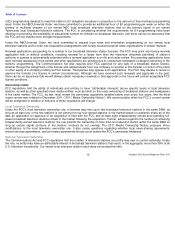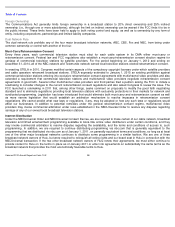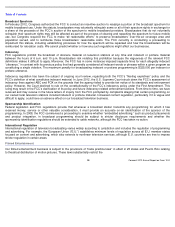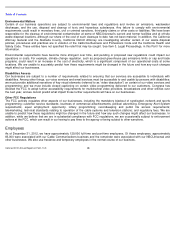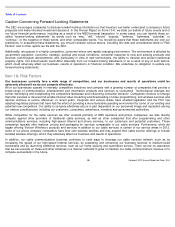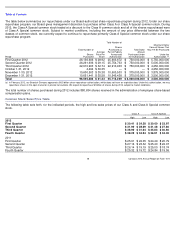Comcast 2012 Annual Report Download - page 34
Download and view the complete annual report
Please find page 34 of the 2012 Comcast annual report below. You can navigate through the pages in the report by either clicking on the pages listed below, or by using the keyword search tool below to find specific information within the annual report.
Table of Contents
services and cable, broadcast and other video programming on the Internet (including high-
quality original video programming that
may be viewed only through digital distribution services), as well as increased access to various media through wireless devices,
have the potential to reduce the viewing of our content through traditional distribution outlets, which could adversely affect the
demand for our video services, the price and amount of advertising that advertisers are willing to purchase from us, the amount
multichannel video providers are willing to pay to NBCUniversal for its content and the levels of DVD and theatrical sales. Some of
these newer technologies also give consumers greater flexibility to watch programming on a time-delayed or on-
demand basis or to
fast-
forward or skip advertisements within our programming, which also may adversely impact the advertising revenue we receive.
Delayed viewing and advertising skipping have become more common as the penetration of DVRs has increased and as content has
become increasingly available via video-on-
demand services and Internet sources. These and other changes in technology,
distribution platforms and consumer behavior could have an adverse effect on our businesses.
Programming expenses for our video services are increasing, which could adversely affect our businesses.
We expect programming expenses for our video services to continue to be our Cable Communications segment’
s largest single
expense item and to increase in the foreseeable future. The multichannel video provider industry has continued to experience an
increase in the cost of programming, especially sports programming. In addition, as we add programming to our video services or
distribute existing programming to more of our customers and through additional delivery platforms, we incur increased programming
expenses. We have begun paying certain local broadcast television stations in exchange for their required consent for the
retransmission of broadcast network programming to our video services customers and expect to continue to be subject to
increasing demands for payment and other concessions from local broadcast television stations. If we are unable to raise our
customers’
rates or offset such programming cost increases through the sale of additional services, the increasing cost of
programming could have an adverse impact on our results of operations. Moreover, as our contracts with content providers expire,
there can be no assurance that they will be renewed on acceptable terms or that they will be renewed at all, in which case we may
be unable to provide such content as part of our video services and our business could be adversely affected.
We are subject to regulation by federal, state, local and foreign authorities, which may impose additional costs and
restrictions on our businesses.
Federal, state and local governments extensively regulate the video services industry and may increase the regulation of the Internet
service and VoIP voice service industries. We expect that legislative enactments, court actions and regulatory proceedings will
continue to clarify, and in some cases may adversely affect, the rights and obligations of cable operators and other entities under the
Communications Act and other laws. Our broadcast television business also is highly regulated by federal laws and regulations, and
our cable networks, filmed entertainment and theme parks businesses are subject to various other laws and regulations at the
international, federal, state and local levels, including laws and regulations relating to environmental protection, which have become
more stringent over time, and the safety of consumer products and theme park operations. In addition, we are subject to the
NBCUniversal Order and the NBCUniversal Consent Decree, which have imposed numerous conditions on our businesses relating
to the treatment of competitors and other matters. Failure to comply with the laws and regulations applicable to our businesses could
result in administrative enforcement actions, fines, and civil and criminal liability.
Legislators and regulators at all levels of government frequently consider changing, and sometimes do change, existing statutes,
rules, regulations, or interpretations thereof, or prescribe new ones, which may significantly affect our businesses. Any future
legislative, judicial, regulatory or administrative actions may increase our costs or impose additional restrictions on our businesses,
which could adversely affect our businesses. For a more detailed discussion of the risks associated with the regulation of all of our
businesses, see “Business – Legislation and Regulation” above.
31
Comcast 2012 Annual Report on Form 10
-
K




